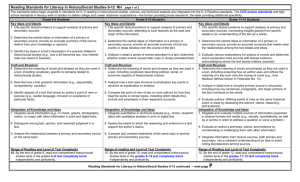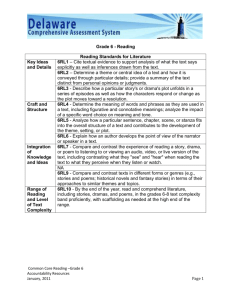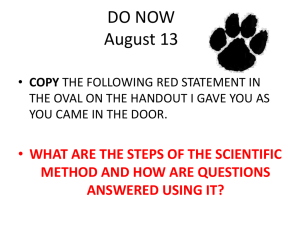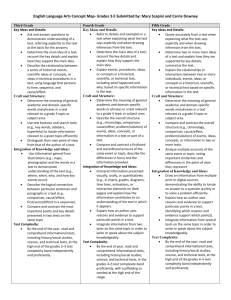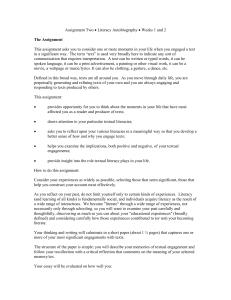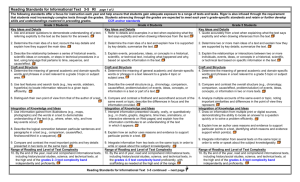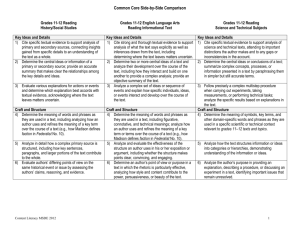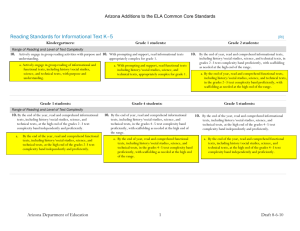6-12 - Erlanger-Elsmere Schools
advertisement
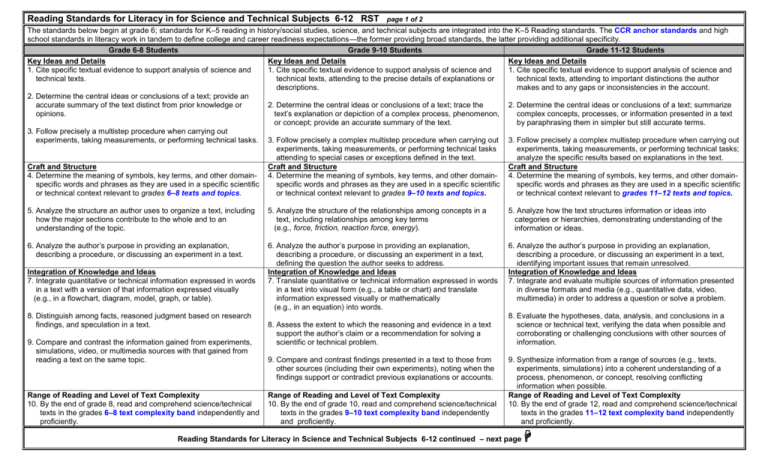
Reading Standards for Literacy in for Science and Technical Subjects 6-12 RST page 1 of 2 The standards below begin at grade 6; standards for K–5 reading in history/social studies, science, and technical subjects are integrated into the K–5 Reading standards. The CCR anchor standards and high school standards in literacy work in tandem to define college and career readiness expectations—the former providing broad standards, the latter providing additional specificity. Grade 6-8 Students Grade 9-10 Students Grade 11-12 Students Key Ideas and Details Key Ideas and Details Key Ideas and Details 1. Cite specific textual evidence to support analysis of science and 1. Cite specific textual evidence to support analysis of science and 1. Cite specific textual evidence to support analysis of science and technical texts. technical texts, attending to the precise details of explanations or technical texts, attending to important distinctions the author descriptions. makes and to any gaps or inconsistencies in the account. 2. Determine the central ideas or conclusions of a text; provide an accurate summary of the text distinct from prior knowledge or 2. Determine the central ideas or conclusions of a text; trace the 2. Determine the central ideas or conclusions of a text; summarize opinions. text’s explanation or depiction of a complex process, phenomenon, complex concepts, processes, or information presented in a text or concept; provide an accurate summary of the text. by paraphrasing them in simpler but still accurate terms. 3. Follow precisely a multistep procedure when carrying out experiments, taking measurements, or performing technical tasks. 3. Follow precisely a complex multistep procedure when carrying out 3. Follow precisely a complex multistep procedure when carrying out experiments, taking measurements, or performing technical tasks experiments, taking measurements, or performing technical tasks; attending to special cases or exceptions defined in the text. analyze the specific results based on explanations in the text. Craft and Structure Craft and Structure Craft and Structure 4. Determine the meaning of symbols, key terms, and other domain- 4. Determine the meaning of symbols, key terms, and other domain- 4. Determine the meaning of symbols, key terms, and other domainspecific words and phrases as they are used in a specific scientific specific words and phrases as they are used in a specific scientific specific words and phrases as they are used in a specific scientific or technical context relevant to grades 6–8 texts and topics. or technical context relevant to grades 9–10 texts and topics. or technical context relevant to grades 11–12 texts and topics. 5. Analyze the structure an author uses to organize a text, including how the major sections contribute to the whole and to an understanding of the topic. 5. Analyze the structure of the relationships among concepts in a text, including relationships among key terms (e.g., force, friction, reaction force, energy). 5. Analyze how the text structures information or ideas into categories or hierarchies, demonstrating understanding of the information or ideas. 6. Analyze the author’s purpose in providing an explanation, describing a procedure, or discussing an experiment in a text. 6. Analyze the author’s purpose in providing an explanation, describing a procedure, or discussing an experiment in a text, defining the question the author seeks to address. Integration of Knowledge and Ideas 7. Translate quantitative or technical information expressed in words in a text into visual form (e.g., a table or chart) and translate information expressed visually or mathematically (e.g., in an equation) into words. 6. Analyze the author’s purpose in providing an explanation, describing a procedure, or discussing an experiment in a text, identifying important issues that remain unresolved. Integration of Knowledge and Ideas 7. Integrate and evaluate multiple sources of information presented in diverse formats and media (e.g., quantitative data, video, multimedia) in order to address a question or solve a problem. Integration of Knowledge and Ideas 7. Integrate quantitative or technical information expressed in words in a text with a version of that information expressed visually (e.g., in a flowchart, diagram, model, graph, or table). 8. Distinguish among facts, reasoned judgment based on research findings, and speculation in a text. 9. Compare and contrast the information gained from experiments, simulations, video, or multimedia sources with that gained from reading a text on the same topic. Range of Reading and Level of Text Complexity 10. By the end of grade 8, read and comprehend science/technical texts in the grades 6–8 text complexity band independently and proficiently. 8. Assess the extent to which the reasoning and evidence in a text support the author’s claim or a recommendation for solving a scientific or technical problem. 9. Compare and contrast findings presented in a text to those from other sources (including their own experiments), noting when the findings support or contradict previous explanations or accounts. Range of Reading and Level of Text Complexity 10. By the end of grade 10, read and comprehend science/technical texts in the grades 9–10 text complexity band independently and proficiently. 8. Evaluate the hypotheses, data, analysis, and conclusions in a science or technical text, verifying the data when possible and corroborating or challenging conclusions with other sources of information. 9. Synthesize information from a range of sources (e.g., texts, experiments, simulations) into a coherent understanding of a process, phenomenon, or concept, resolving conflicting information when possible. Range of Reading and Level of Text Complexity 10. By the end of grade 12, read and comprehend science/technical texts in the grades 11–12 text complexity band independently and proficiently. Reading Standards for Literacy in Science and Technical Subjects 6-12 continued – next page Reading Standards for Literacy in for Science and Technical Subjects 6-12 RST page 2 of 2 Depth of Knowledge DOK 1 DOK 2 DOK 3 DOK 4 Program of Studies Transformations MG Reading 1.2 2.24 2.25 Communication Skills 1.3 1.4 1.12 Problem Solving Skills 5.1 5.2 5.3 5.4 5.5 Con. & Integrating Knowledge 6.1 6.2 6.3 HS 1.2 2.24 1.3 1.4 5.1 5.2 5.3 6.1 6.2 2.25 1.12 5.4 5.5 6.3 Resources Bloom’s Taxonomy Bloom’s & William’s Taxonomy CPE’s NAEP Distributions in Reading & Writing Core Standards Glossary WEB Resources Kentucky Department of Education US Department of Education Core Standards International Reading Association National Council of Teachers of English Lexiles
